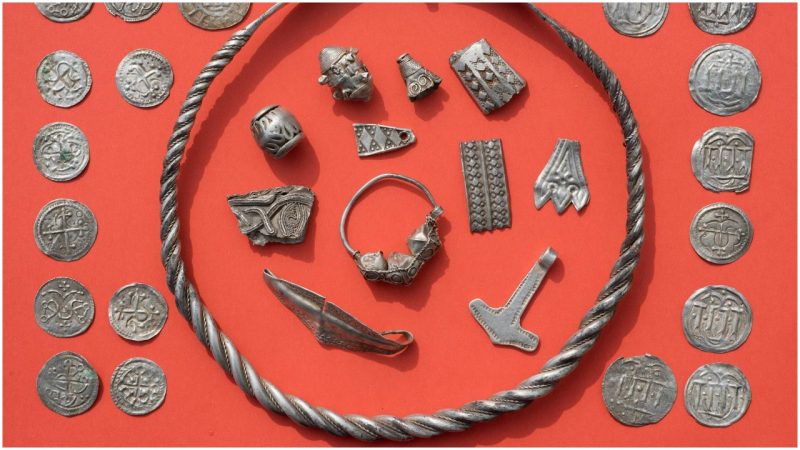Every once in a while, an amateur archaeologist is fortunate enough to make a big discovery. Just recently, a 13-year-old German boy, Luca Malaschnichenko, took part in finding a trove of Viking medieval treasures, along with an amateur archaeologist, René Schön. The twosome came across the discoveries in January 2018 while wandering the area of Schaprode on the German island of Rügen with metal detectors.
As was later confirmed, the site was linked to the fabulous King Harald “Bluetooth” Gormsson, whom today we associate with the wireless Bluetooth technology. The Danish king most likely occupied the throne from 958 until 986 A.D., during which time Christianity was introduced to his territories.
German news agencies reported that Schön and Malaschnichenko came across what they first believed was just a piece of cheap aluminum. Quickly enough, the pair realized the item was made of silver. In a follow-up excavation effort on the site in April, now supported by professional archaeologists, an entire cache of items believed to be associated with King Harald Bluetooth surfaced in the area that encompassed some 4,300 square feet.
Archaeologists recovered a great many significant artifacts and prominent jewelry pieces such as braided necklaces, rings, pearls, brooches, Thor’s hammer, and over 600 coins, of which at least hundred are believed to have been minted under the reign of Bluetooth. As the BBC further reports, some of the coins have Christian crosses on them and were disseminated among Danish nobles.

According to Michael Schirren, the lead archaeologist, the finding officially counts as “the biggest single discovery of Bluetooth coins in the southern Baltic Sea region,” he told national German agency DPA. A Damascus dirham dated to the year 714 A.D. appears to be the earliest-dated coin, while the latest is a penny minted most probably in 983 A.D., the Guardian said.
It’s believed that the treasures were deployed at the site by the end of the 980s, around the time Harald Bluetooth was forced to flee his kingdom to Pomerania, a historic area in the northeast of Europe extending along the coast of the Baltic between two major rivers, Oder and Vistula. The legendary king died in that area in 987 A.D.
Harald Bluetooth ventured to Pomerania after losing power in a battle with Sweyn Forkbeard, his mutinous son who took the throne immediately. Some parties have even raised the question of what are the odds the freshly-found treasures were buried on the island by the king himself while running away from enemies, though that is hard to determine.
While Forkbeard is best remembered to history as one of England’s shortest-lived kings, his father Bluetooth is believed to have unified various territorial units of Denmark. Bluetooth strengthened his kingdom by building new fortifications, introducing new religion in the country, and claiming territories in neighboring Norway, Sweden, and Germany. Not all details about his life are known to historians, however, including the exact year he was born.
His famed nickname, which today depicts the name of the Bluetooth technology, reportedly got the earliest mention in the Roskilde Chronicle of 1140, and various parties have postulated theories to explain the usage of this particular (and peculiar) nickname. One of them says the Danish king had a damaged tooth colored blue. Another says he enjoyed eating blueberries, hence he got a blue tooth because of that. A third, perhaps a more logical one, speculates he gained the nickname because of the blue clothing he wore to signal his status as royalty.
This king is also historically remembered for being a superbly communicative person, a reason why his nickname was selected to name a modern-day project that went on to master the wireless tech, and it ultimately remained in usage.
The recent archaeological find of the 13-year-old boy and an amateur archaeologist was perhaps not entirely down to just being lucky. The region around Rügen has already been associated with more findings linked to Bluetooth in the past, such as pieces of gold jewelry found on the neighboring island of Hiddensee in the 19th century.
